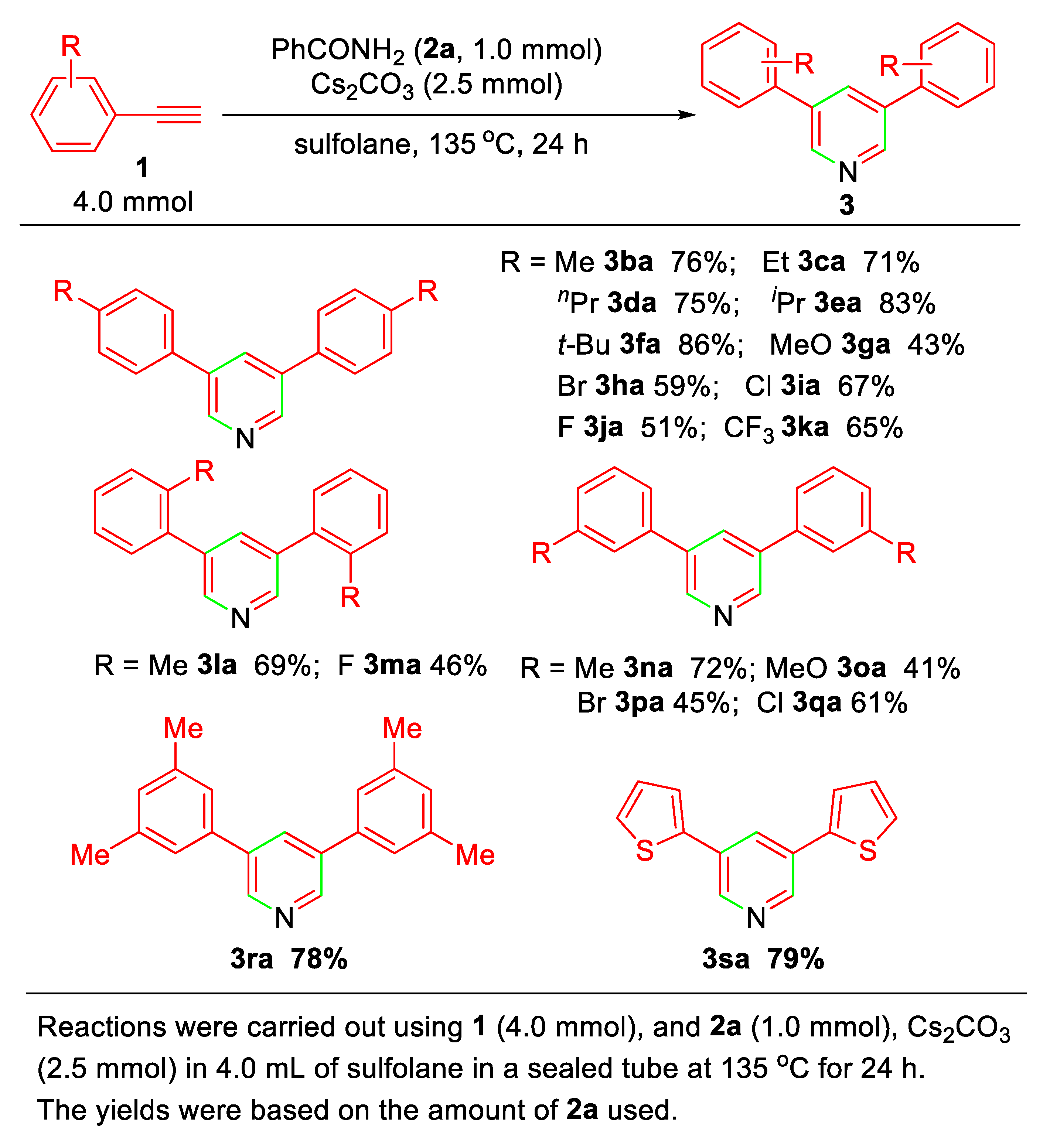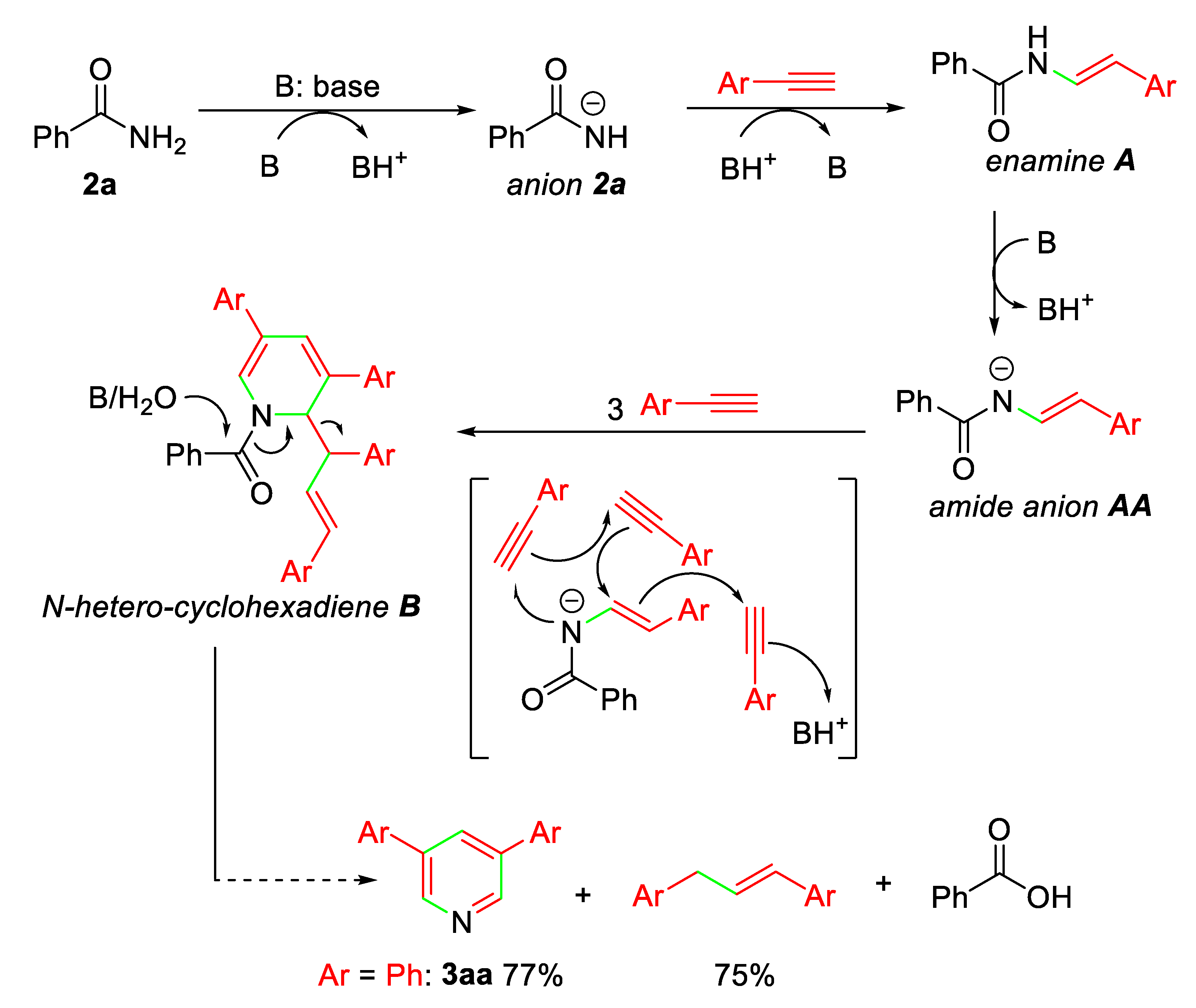Base-Promoted One-Pot Synthesis of Pyridine Derivatives via Aromatic Alkyne Annulation Using Benzamides as Nitrogen Source
Abstract
:1. Introduction
2. Results and Discussion
3. Materials and Methods
3.1. General Methods
3.2. Typical Experimental Procedure for the Synthesis of 3,5-Diphenyl Pyridine (3aa)
4. Conclusions
Supplementary Materials
Author Contributions
Funding
Institutional Review Board Statement
Informed Consent Statement
Data Availability Statement
Acknowledgments
Conflicts of Interest
Sample Availability
References
- Baumann, M.; Baxendale, I.R. An overview of the synthetic routes to the best-selling drugs containing 6-membered heterocycles. Beilstein J. Org. Chem. 2013, 9, 2265–2319. [Google Scholar] [CrossRef] [PubMed] [Green Version]
- Altaf, A.A.; Shahzad, A.; Gul, Z.; Rasool, N.; Badshah, A.; Lal, B.; Khan, E. A review on the medicinal importance of pyridine derivatives. J. Drug Des. Med. Chem. 2015, 1, 1–11. [Google Scholar]
- Prachayasittikul, S.; Pingaew, R.; Worachartcheewan, A.; Sinthupoom, N.; Prachayasittikul, V.; Ruchirawat, S.; Prachayasittikul, V. Roles of pyridine and pyrimidine derivatives as privileged scaffolds in anticancer agents. Mini-Rev. Med. Chem. 2017, 17, 869–901. [Google Scholar] [CrossRef] [PubMed]
- El-Sayed, H.A.; Moustafa, A.H.; El-Torky, A.E.; Abd El-Salam, E.A. A series of pyridines and pyridine-based sulfa-drugs as antimicrobial agents: Design, synthesis and antimicrobial activity. Russ. J. Gen. Chem. 2017, 87, 2401–2408. [Google Scholar] [CrossRef]
- Bagley, M.C.; Glover, C.; Merritt, E.A. The Bohlmann–Rahtz pyridine synthesis: From discovery to applications. Synlett 2007, 2459–2482. [Google Scholar] [CrossRef]
- Aida, W.; Ohtsuki, T.; Li, X.; Ishibashi, M. Isolation of new carbamate- or pyridine-containing natural products, fuzanins A, B, C, and D from Kitasatospora sp. IFM10917. Tetrahedron 2009, 65, 369–373. [Google Scholar] [CrossRef]
- Hudson, G.A.; Hooper, A.R.; DiCaprio, A.J.; Sarlah, D.; Mitchell, D.A. Structure prediction and synthesis of pyridine-based macrocyclic peptide natural products. Org. Lett. 2021, 23, 253–256. [Google Scholar] [CrossRef]
- Nakamura, I.; Yamamoto, Y. Transition-metal-catalyzed reactions in heterocyclic synthesis. Chem. Rev. 2004, 104, 2127–2198. [Google Scholar] [CrossRef]
- Henry, G.D. De novo synthesis of substituted pyridines. Tetrahedron 2004, 60, 6043–6061. [Google Scholar] [CrossRef]
- Heller, B.; Hapke, M. The fascinating construction of pyridine ring systems by transition metalcatalysed [2+2+2] cycloaddition reactions. Chem. Soc. Rev. 2007, 36, 1085–1094. [Google Scholar] [CrossRef] [PubMed]
- Maryanoff, B.E.; Zhang, H.-C. Pyridine-containing macrocycles via cobalt-mediated [2+2+2] cycloadditions of α,ω-bis-alkynes. Arkivoc 2007, 7–35. [Google Scholar] [CrossRef] [Green Version]
- Varela, J.A.; Saá, C. Recent advances in the synthesis of pyridines by transition-metal-catalyzed [2+2+2] cycloaddition. Synlett 2008, 2571–2578. [Google Scholar]
- Hill, M.D. Recent strategies for the synthesis of pyridine derivatives. Chem. Eur. J. 2010, 16, 12052–12062. [Google Scholar] [CrossRef] [PubMed]
- Hua, R.; Abrenica, M.V.A.; Wang, P. Cycloaddition of alkynes: Atom-economic protocols for constructing six-membered cycles. Curr. Org. Chem. 2011, 15, 712–729. [Google Scholar] [CrossRef]
- Gulevich, A.V.; Dudnik, A.S.; Chernyak, N.; Gevorgyan, V. Transition metal-mediated synthesis of monocyclic aromatic heterocycles. Chem. Rev. 2013, 113, 3084–3213. [Google Scholar] [CrossRef] [Green Version]
- Allais, C.; Grassot, J.-M.; Rodriguez, J.; Constantieux, T. Metal-free multicomponent syntheses of pyridines. Chem. Rev. 2014, 114, 10829–10868. [Google Scholar] [CrossRef] [PubMed]
- Vessally, E.; Hosseinian, A.; Edjlali, L.; Bekhradnia, A.; Esrafili, M.D. New page to access pyridine derivatives: Synthesis from N-propargylamines. RSC Adv. 2016, 6, 71662–71675. [Google Scholar] [CrossRef]
- Zheng, L.; Hua, R. C–H activation and alkyne annulation via automatic or intrinsic directing groups: Towards high step economy. Chem. Rec. 2018, 18, 556–569. [Google Scholar] [CrossRef]
- Zheng, L.; Hua, R. Recent advances in construction of polycyclic natural product scaffolds via one-pot reactions involving alkyne annulation. Front. Chem. 2020, 8, 580355. [Google Scholar] [CrossRef]
- Hua, R. Isoquinolone syntheses by annulation protocols. Catalysts 2021, 11, 620. [Google Scholar] [CrossRef]
- Zhou, Y.; Hua, R. Synthesis of 1-benzyl-, 1-alkoxyl-, and 1-aminoisoquinolines via rhodium(III)-catalyzed aryl C−H activation and alkyne annulation. J. Org. Chem. 2021, 86, 8862–8872. [Google Scholar] [CrossRef]
- Zheng, L.; Ju, J.; Bin, Y.; Hua, R. Synthesis of isoquinolines and heterocycle-fused pyridines via three-component cascade reaction of aryl ketones, hydroxylamine, and alkynes. J. Org. Chem. 2012, 77, 5794–5800. [Google Scholar] [CrossRef]
- Wang, P.; Hua, R.; Li, C.-J. One-pot synthesis of unsymmetrical 2,4,6-triaryl pyridines by the oxidative cyclocondensation of benzaldehydes, aromatic alkynes and ammonium bifluoride. Curr. Org. Synth. 2013, 10, 655–660. [Google Scholar] [CrossRef]
- Nizami, T.A.; Hua, R. Silver-catalyzed chemoselective annulation of propargyl amines with alkynes for access to pyridines and pyrroles. Tetrahedron 2017, 73, 6080–6084. [Google Scholar] [CrossRef]
- Su, J.; Chen, Q.; Lu, L.; Ma, Y.; Auyoung, G.H.L.; Hua, R. Base-promoted nucleophilic fluoroarenes substitution of C-F bonds. Tetrahedron 2018, 74, 303–307. [Google Scholar] [CrossRef]
- Iqbal, M.A.; Lu, L.; Mehmood, H.; Khan, D.M.; Hua, R. Quinazolinone synthesis through base-promoted SNAr reaction of ortho-fluorobenzamides with amides followed by cyclization. ACS Omega 2019, 4, 8207–8213. [Google Scholar] [CrossRef] [Green Version]
- Iqbal, M.A.; Mehmood, H.; Lv, J.; Hua, R. Base-promoted SNAr reactions of fluoro- and chloroarenes as a route to N-aryl indoles and carbazoles. Molecules 2019, 24, 1145. [Google Scholar] [CrossRef] [PubMed] [Green Version]
- Chen, Q.; Wang, Y.; Hua, R. Base-promoted chemodivergent formation of 1,4-benzoxazepin-5(4H)-ones and 1,3-benzoxazin-4(4H)-ones switched by solvents. Molecules 2019, 24, 3773. [Google Scholar] [CrossRef] [Green Version]
- Mehmood, H.; Iqbal, M.A.; Lu, L.; Hua, R. Base-promoted annulation of amidoximes with alkynes: Simple access to 2,4-disubstituted imidazoles. Molecules 2020, 25, 3621. [Google Scholar] [CrossRef]
- Iqbal, M.A.; Lu, L.; Mehmood, H.; Hua, R. Biaryl formation via base-promoted direct coupling reactions of arenes with aryl halides. ACS Omega 2021, 6, 15981–15987. [Google Scholar] [CrossRef]
- Li, Z.; Huang, X.; Chen, F.; Zhang, C.; Wang, X.; Jiao, N. Cu-catalyzed concise synthesis of pyridines and 2-(1H)-pyridones from acetaldehydes and simple nitrogen donors. Org. Lett. 2015, 17, 584–587. [Google Scholar] [CrossRef]
- Sathish, M.; Chetna, J.; Krishna, N.H.; Shankaraiah, N.; Alarifi, A.; Kamal, A. Iron-mediated one-pot synthesis of 3,5-diarylpyridines from β-nitrostyrenes. J. Org. Chem. 2016, 81, 2159–2165. [Google Scholar] [CrossRef]
- Ranjani, G.; Nagarajan, R. Insight into copper catalysis: In situ formed nano Cu2O in Suzuki-Miyaura cross-coupling of aryl/indolyl boronates. Org. Lett. 2017, 19, 3974–3977. [Google Scholar] [CrossRef]
- Tilstam, U. Sulfolane: A versatile dipolar aprotic solvent. Org. Process Res. Dev. 2012, 16, 1273–1278. [Google Scholar] [CrossRef]
- Kurc, B. Sulfolane with LiPF6, LiNTf2 and LiBOB—as a non-flammable electrolyte working in a lithium-ion batteries with a LiNiO2 cathode. Int. J. Electrochem. Sci. 2018, 13, 5938–5955. [Google Scholar] [CrossRef]
- Cox, R.A.; Druet, L.M.; Klausner, A.E.; Modro, T.A.; Wan, P.; Yates, K. Protonation acidity constants for some benzamides, acetamides, and lactams. Can. J. Chem. 1980, 59, 1568–1573. [Google Scholar] [CrossRef]





| Entry | 2a (mmol) | Base (mmol) | Solvent | Yield (%) |
|---|---|---|---|---|
| 1 | benzamide (2.0) | KOtBu (4.0) | DMSO | trace |
| 2 | benzamide (2.0) | KOH (4.0) | DMSO | trace |
| 3 | benzamide (2.0) | K2CO3 (4.0) | DMSO | trace |
| 4 | benzamide (2.0) | Cs2CO3 (4.0) | DMSO | 20 b |
| 5 | benzamide (2.0) | Cs2CO3 (4.0) | THF | 0 |
| 6 | benzamide (2.0) | Cs2CO3 (4.0) | dioxane | trace |
| 7 | benzamide (2.0) | Cs2CO3 (4.0) | DMF | trace |
| 8 | benzamide (2.0) | Cs2CO3 (4.0) | DMAc | 15 b |
| 9 | benzamide (2.0) | Cs2CO3 (4.0) | sulfolane | 25 b |
| 10 | benzamide (3.0) | Cs2CO3 (4.0) | sulfolane | 16 b |
| 11 | benzamide (1.0) | Cs2CO3 (2.5) | sulfolane | 77 c |
| 12 | benzamide (1.0) | Cs2CO3 (1.5) | sulfolane | 63 c |
| 13 | benzamide (1.0) | Cs2CO3 (2.5) | DMSO | 33 c |
| 14 | benzamide (1.0) | Cs2CO3 (2.5) | DMF | 0 |
| 15 | benzamide (1.0) | Cs2CO3 (2.5) | formamide | 0 |
| 16 | benzamide (1.0) | Cs2CO3 (2.5) | DMAc | 25 c |
| 17 | NH4OAc (1.0) | Cs2CO3 (2.5) | sulfolane | 0 |
| 18 | acetamide (1.0) | Cs2CO3 (2.5) | sulfolane | 0 |
| 19 | benzamide (1.0) | -- | sulfolane | 0 |
Publisher’s Note: MDPI stays neutral with regard to jurisdictional claims in published maps and institutional affiliations. |
© 2021 by the authors. Licensee MDPI, Basel, Switzerland. This article is an open access article distributed under the terms and conditions of the Creative Commons Attribution (CC BY) license (https://creativecommons.org/licenses/by/4.0/).
Share and Cite
Mehmood, H.; Iqbal, M.A.; Ashiq, M.N.; Hua, R. Base-Promoted One-Pot Synthesis of Pyridine Derivatives via Aromatic Alkyne Annulation Using Benzamides as Nitrogen Source. Molecules 2021, 26, 6599. https://doi.org/10.3390/molecules26216599
Mehmood H, Iqbal MA, Ashiq MN, Hua R. Base-Promoted One-Pot Synthesis of Pyridine Derivatives via Aromatic Alkyne Annulation Using Benzamides as Nitrogen Source. Molecules. 2021; 26(21):6599. https://doi.org/10.3390/molecules26216599
Chicago/Turabian StyleMehmood, Hina, Muhammad Asif Iqbal, Muhammad Naeem Ashiq, and Ruimao Hua. 2021. "Base-Promoted One-Pot Synthesis of Pyridine Derivatives via Aromatic Alkyne Annulation Using Benzamides as Nitrogen Source" Molecules 26, no. 21: 6599. https://doi.org/10.3390/molecules26216599
APA StyleMehmood, H., Iqbal, M. A., Ashiq, M. N., & Hua, R. (2021). Base-Promoted One-Pot Synthesis of Pyridine Derivatives via Aromatic Alkyne Annulation Using Benzamides as Nitrogen Source. Molecules, 26(21), 6599. https://doi.org/10.3390/molecules26216599







